 1.
Recattering processes:
1.
Recattering processes:2007-2008 hightlights :
We have established theoretically that it is possible to use few-cycle infrared lasers to image the time-resolved chemical transformation with temporal resolution of a few femtoseconds. Using a pump beam (IR laser, xuv attosecond pulses, free-electron x-ray lasers) to initiate the chemical transformation, we suggest that the transient molecules are then probed with few-cycle infrared lasers with different time delays. Experimentally one measures the laser-induced high-energy photoelectrons, or the high-order harmonic generations.
Our theory establishes that laser-induced photoelectron momentum distributions and high-order harmonic generation can be used to retrieve elastic scattering cross sections of the target ion by free electrons, and the photo-recombination cross sections. These information can then be used to retrieve the structure of the target, with the time resolution determined by the pulse duration of the probe lasers.
(more details see papers 309,310, 311, 312 and others here)
Below is a schematic description:
 1.
Recattering processes:
1.
Recattering processes:
The red line in (a) below depicts the electric field a few cycle laser pulse. Electrons that are released by the laser near point a will return to revisit the target at b (about 1fs later). If the electrons are scattered into the backward directions by the target ion then it will be accelerated by the laser's electric field, thus emerging as high energy electrons. This is depicted in (b). For back scattering to occur, the electrons have to come very close to the target ion, thus they carry information about the structure of the target-- as one would from shining a beam of electrons onto the target in the standard electron diffraction experiment.
Fig. 1
2. Extracting electron-ion scattering cross sections from laser-induced 2D electron momentum distributions
Below are the photoelectron momentum distributions for hydrogen and argon atoms generated by the same laser pulse (obtained from "exact" theoretical calculations). Note the outermost "rings" or "ridges"-- these electrons are backscattered electrons. They lie on a semi-circle with the center shifted. Its center is shifted because when an electron is backscattered at point b in Fig. 1(a), it has a vector potential -- that is to say that it is further accelerated to gain a momentum measured by the vector potential at b, after it emerges from the laser field to the detector.
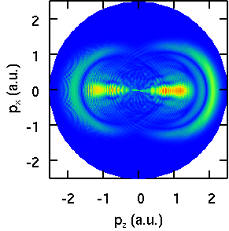
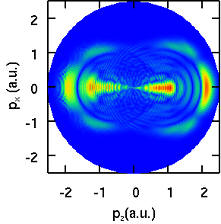
Fig.2. photoelectron momentum distributions of H (left) and Ar (right) generated by the same laser pulse. Note the clear difference in the outermost ring in the two frames. From the yields along each ring, we can extract the differential cross sections which can be compared directly to the e-+H+ and to e-+Ar+ cross sections by free electrons. See the comparison below, plus examples from Ne and Xe.
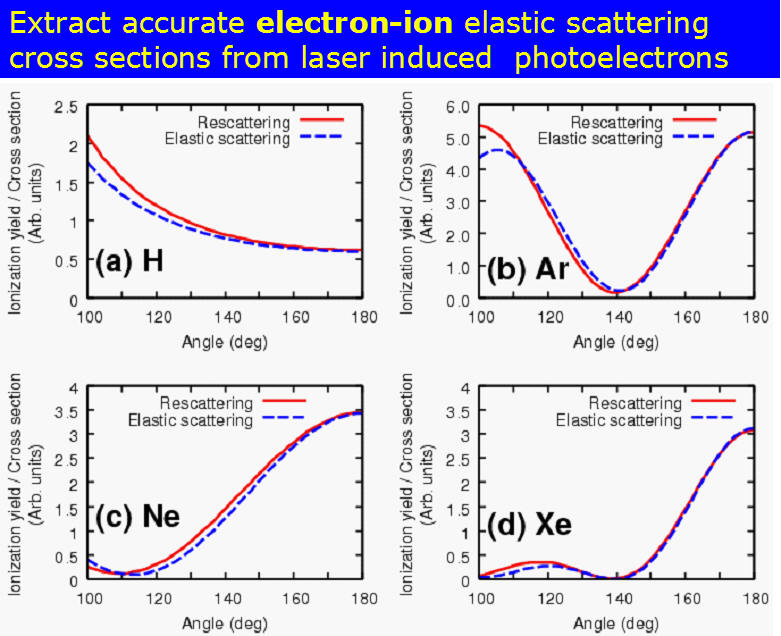
These predictions have now been confirmed experimentally.
3. Extracting photo-recombination cross sections from high-order harmonic spectra
By expressing (HHG amplitude)= (wave packet) x (recombination dipole) using the model that the HHG is generated by photo-recombination of a returning electron wave packet with the target ion, and comparing the HHG generated by two targets of comparable ionization potential, the dipole moment of the unknown (or the more complicated) target can be obtained. This is because the returning electron wave packet is insensitive to the target structure. Using accurate results from theoretical calculations for HHG generated from Ar and from a companion H with the same ionization potential, we can extract the photoionization cross section of Ar, and the phase of its dipole matrix element, from the HHG spectra. Below are examples
cross section phase
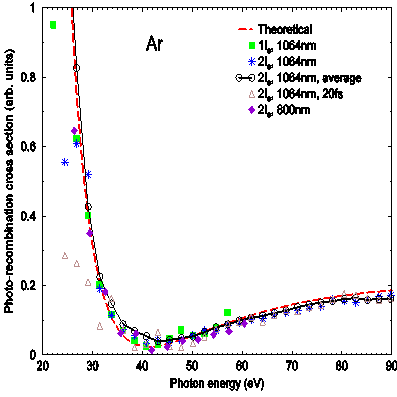
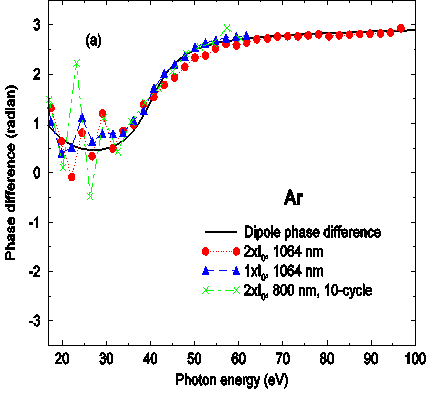
Recently we have also established that the HHG generated by H2+ molecules can also be extracted in the same way, thus proving that indeed the structure of molecules can be extracted from measured HHG spectra.